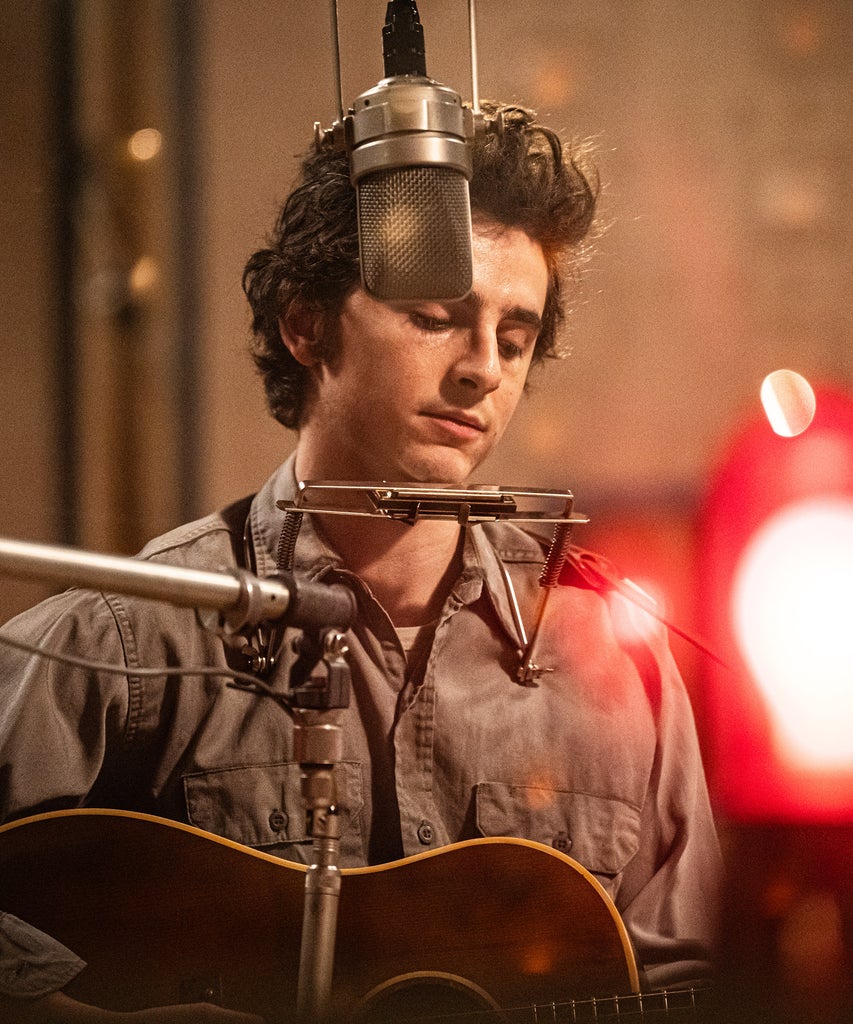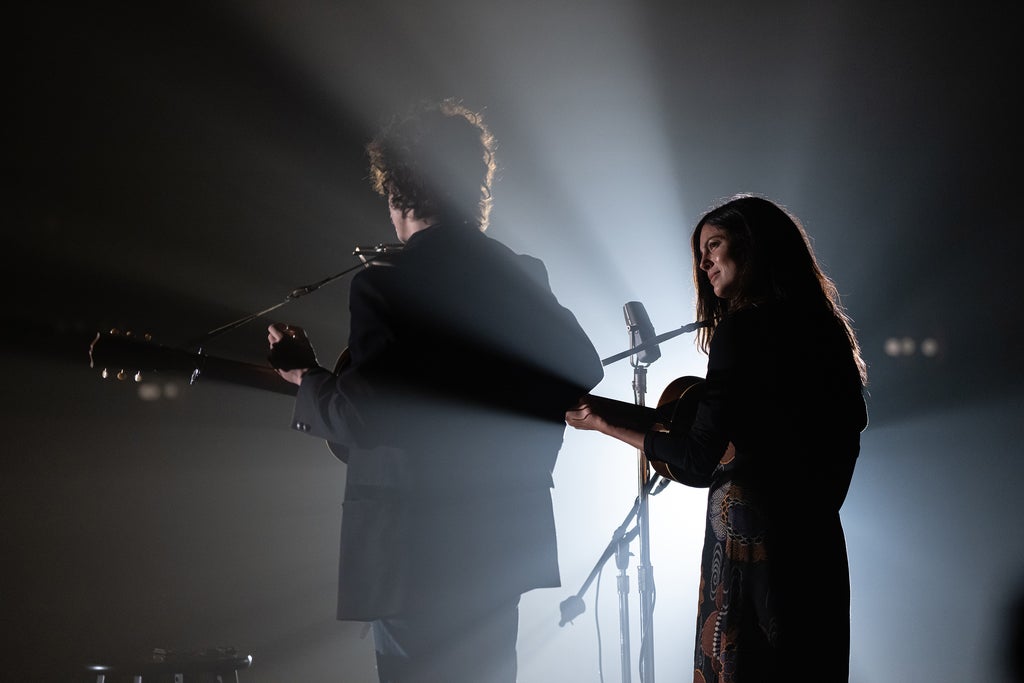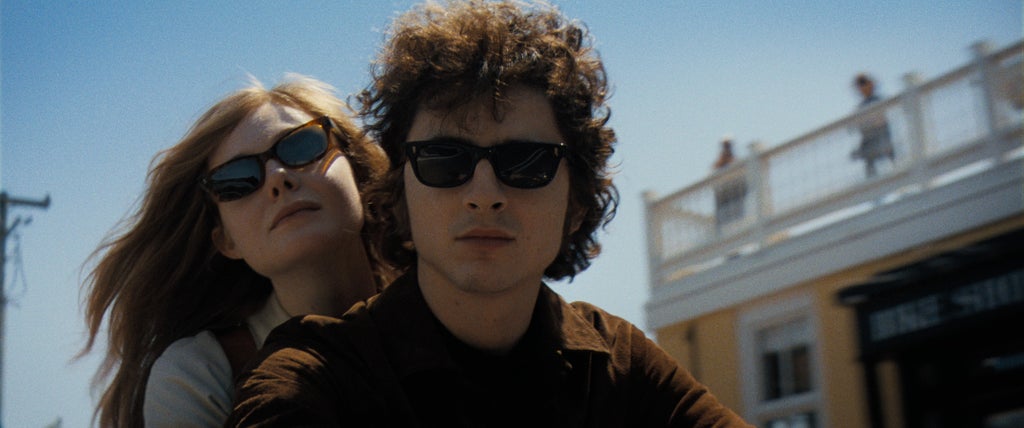
Minor spoilers ahead. Depending how you see it, Bob Dylan — the 1960s folk singer who became the voice of a generation — was either an artistic genius or an arrogant, self-involved jerk. The latter is the conclusion fellow folk singer Joan Baez seemingly comes to in James Mangold’s latest film A Complete Unknown, a biopic that looks at the early years of Dylan’s career. It’s 1965 in New York City, and Bob (Timothée Chalamet), deep into his infamy and questioning where to go next in his songwriting, visits frequent collaborator and sometimes girlfriend Joan (Monica Barbaro) in her room at the Chelsea Hotel. He’s there to see her, but really, he isn’t — he just needs to be in the same room as her, staying up into the late hours writing music and strumming his guitar while she tries to sleep beside him. Frustrated, Joan kicks him out, but not before asking why he even came to see her in the first place, or rather “to make me watch you write?” For his part, Bob can’t really answer.
The notion of the artist/muse relationship isn’t anything new in 2024 or ever in creative history. For pretty much as long as there’s been art, there have been the people who inspire and influence it: Mexican painter Diego Rivera had his wife Frida Kahlo. Andy Warhol had model Edie Sedgwick. Kurt Cobain had his tumultuous relationship with Courtney Love. And Bob Dylan had Suze Rotolo (renamed Sylvie in the film) and Joan Baez.
Throughout the film, these two women shape the Minnesota-born singer from a listless folk fanboy with limited perspective into the eventual superstar. Both his muses in differing ways, a lot of their respective relationships feel informed by a one-way dynamic, in which Bob takes — first from Sylvie (Elle Fanning), who introduces him to the subject matter that made him famous, and then from Joan, who is a sounding board to write and create his music. It’s thankless work and often overlooked. But unlike explorations of this taut dynamic before it, Mangold’s film subtly grapples with what exactly this taking looks like. When it gives us life-changing art like Dylan’s, is it actually worth it?
“I [have] a lot of different feelings about that kind of question,” Timothée Chalamet tells Refinery29 during a press day for the film. For the actor, it’s important for audiences to remember that these characters — and their real-life counterparts — are in their early 20s when we meet them in 1961. Dylan himself came to New York City when he was just 19, Baez was 20, and Rotolo only 17. “Life is a mess at that age and everyone’s on their first life,” Chalamet says, “certainly Sylvie, Joan Baez, and Bob Dylan were, so these aren’t experienced hands at the game of life, in one sense.”
Throughout the film, Bob might be physically present with both Joan and Sylvie, but his undivided attention is always seemingly just out of their grasp. He strums a new chord, hums a new song, or workshops lyrics in his head, all while they’re trying to connect with him. His true goal, and love, are pretty clear. “I hope [the] audience sees that Bob Dylan is focused on his craft first and foremost on his art,” Chalamet says. “It’s what brings him to New York, it’s his gift in the movie… his main drive is always his art and his music.”

Monica Barbaro notes Joan and Bob’s historically push-and-pull relationship. As a fellow artist, and in line with other artistic couplings, Baez took inspiration right back. Already the “Queen of Folk” when she first meets Bob, “for [Joan], he offered words to say the things that she was wanting to say in her performances,” Barbaro says. “She was at a point where she was feeling a bit of a disassociation with the fame, and she really wanted to use this platform that she had to speak about all kinds of things; human suffering and hypocrisy, and I think he was a source of that for her.” It’s a refreshing perspective on their relationship given the usual one-way dynamics of a typical muse/artist relationship, that, at least for Barbaro, she saw the mutual benefit in Joan and Bob’s relationship.
But the waters become murkier when it comes to the dynamic between Bob and his first, and non-famous, love.
Based on Dylan’s IRL girlfriend Suze Rotolo, who appeared on the cover of The Freewheelin’ Bob Dylan album and inspired some of his greatest songs like “Boots of Spanish Leather” and “Don’t Think Twice, It’s All Right,” Sylvie gets a deeper dive through the movie. It’s Sylvie who introduces the newly arrived New York City transplant to many of the themes he would later incorporate in his music and that would inevitably make Bob such a prolific figure — sharing her activism with him and influencing his pivot in writing from common themes about the American Dust Bowl to more social and political issues like racial injustice and war. Sylvie also provides emotional and physical support as Bob’s career skyrockets, as any romantic partner does, and in spite of the philandering that comes with it; meanwhile, Sylvie, a student when we first meet her, is seemingly overlooked and left in the shadow of his limelight. As the real Rotolo told NPR in a 2008 interview about their relationship during this period of time, “I felt more and more insecure, that I was just this string on his guitar; I was just this chick. And I was losing confidence in who I was.”

In many ways, it feels like without Sylvie, there would be no Bob; so shouldn’t she be given her dues? Fanning, who portrays Sylvie, sees it differently. “[He’s] honest from the jump about who he is,” the actress tells Refinery29. “I don’t necessarily think it’s all bad.”
It doesn’t seem that the real Rotolo saw it that way either. In the same interview with NPR, Rotolo talked about making conscious decisions for herself and her career, eventually leaving the suffocating world of Greenwich Village and Dylan’s fame, something that would eventually lead to the couple splitting up in 1963. “I think [Sylvie] certainly does not want to be a victim or a martyr, or I don’t think she wants anyone to feel bad for her,” Fanning says. “I think it’s just the circumstance that she’s in.”
Both Sylvie and Joan are, like Bob himself, just trying to figure out who they even are, both in relation to this man and independent of it.
That’s exactly what both women do, at least in the film, if not in real life — realizing, in their own separate ways, that they’ve contributed all that they can give, making the decision for themselves to move beyond him. “There is a heartbreaking quality to the end,” Fanning says, “but I think it’s actually kind of bittersweet.” Not to mention triumphant, with Sylvie making the decision to leave. “In order for her to flourish and become her full self, she also has to let him go and not live in the shadows of this man,” Fanning says.
While Barbaro hasn’t had much time to process these scenes since the movie wrapped in June, in many ways that final confrontation between Baez and Dylan at the Chelsea Hotel feels like a full assertion of her independence and worth. “To be in a relationship with someone, there’s a limit and there’s boundaries you have to establish with your work and your life — and he didn’t have it,” Barbaro says. “It’s a part of what makes him a genius, and I think she really loved that about him and I think in a lot of ways she actually facilitated his ability to write in real life and admired everything he wrote and would sing things back and try to be of assistance in that creative process, but I think there’s a limit and I think there’s a point that she had to draw the line.”
And, that doesn’t mean that their work — and impact — on Dylan and the era can’t be appreciated now. Dylan himself played a role in Mangold’s film, sitting down with the director to provide notes on the script. The singer has also wrote about Rotolo’s impact on his art in his 2004 memoir Chronicles: Volume One. So maybe, in his own way, the real Dylan — now 83 years old — is reflecting on his career, looking beyond the music to the women who helped him create it.
A Complete Unknown is in theaters December 25.
Like what you see? How about some more R29 goodness, right here?
Timothée Chalamet’s Fave Video Game Is A Throwback
The Full, Freewheelin' Guide To Bob Dylan
The Best TV Shows & Movies To Watch In December
from Refinery29 https://ift.tt/cwbBZIJ
via IFTTT
